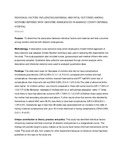| dc.contributor.author | Kandie, P | |
| dc.contributor.author | Kipmerewo, M. | |
| dc.contributor.author | Mukabana, B | |
| dc.contributor.author | Arudo, J | |
| dc.date.accessioned | 2021-12-14T13:10:42Z | |
| dc.date.available | 2021-12-14T13:10:42Z | |
| dc.date.issued | 2021-02-08 | |
| dc.identifier.uri | https://doi.org/10.47604/jhmn.1217 | |
| dc.identifier.uri | https://www.iprjb.org/journals/index.php/JHMN/article/view/1217 | |
| dc.identifier.uri | http://ir-library.mmust.ac.ke:8080/xmlui/handle/123456789/1826 | |
| dc.description.abstract | Purpose: To determine the association between individual factors and maternal and fetal outcomes among mothers referred with obstetric emergencies.
Methodology: A descriptive cross-sectional study which employed a mixed method approach of data collection was adopted. Simple Random technique was used in selecting 284 respondents into the study. The study population also included nurses, gynaecologist and medical officers who were purposively sampled. Qualitative data collection was analysed through content analysis while descriptive and inferential statistics were used to analysed quantitative data.
Findings: The odds were lower for Neonates of mothers who did not have complications immediately post-delivery (OR:0.2;95% CI: 0.1-.8; P=0.01) compared with mothers who had complications. Neonates whose mothers received haematinics and IPT had 50% lower rate of complications than those who did not(OR:0.5;95% CI:0.2-1.0;P=0.04).The odds of abnormal births were higher for mothers without any income compared to those with some income (OR:1.7;95% CI 1.0-2.7;P=0.04).Moreover, neonates of mothers with no or with primary education were 1.7 times more likely to have had abnormal outcome (OR:1.7;95% CI 1.0-2.9;P=0.03)than those cases where the mother had secondary education and above. Further results show that women who decided by themselves to attend ANC were 95.5% less likely to have had complications (OR:0.4;95%CI:0.1; -1.0P=0.07). Gestational age of less than 39 weeks was associated with an increase in the odds of having maternal complications with up to 10.4 times likelihood of having complications (OR:0.4;95% CI:O.1; P=0.07)
Unique contribution to theory, practice and policy: This study has identified individual factors influencing maternal and fetal outcomes of obstetric emergencies in a marginalized county. The findings will provide insight to policy makers at the county level hence informed interventions will be made. The study will also form a basis for other researchers because no literature review has been published on this topic at the study site. | en_US |
| dc.language.iso | en | en_US |
| dc.publisher | Journal of Health, Medicine and Nursing | en_US |
| dc.subject | INDIVIDUAL, FACTORS, INFLUENCING, MATERNAL, FETAL, OUTCOMES, AMONG, MOTHERS, REFFERED , OBSTETRIC, EMERGENCIES | en_US |
| dc.title | INDIVIDUAL FACTORS INFLUENCING MATERNAL AND FETAL OUTCOMES AMONG MOTHERS REFFERED WITH OBSTETRIC EMERGENCIES IN BARINGO COUNTY REFERRAL HOSPITAL | en_US |
| dc.type | Article | en_US |

